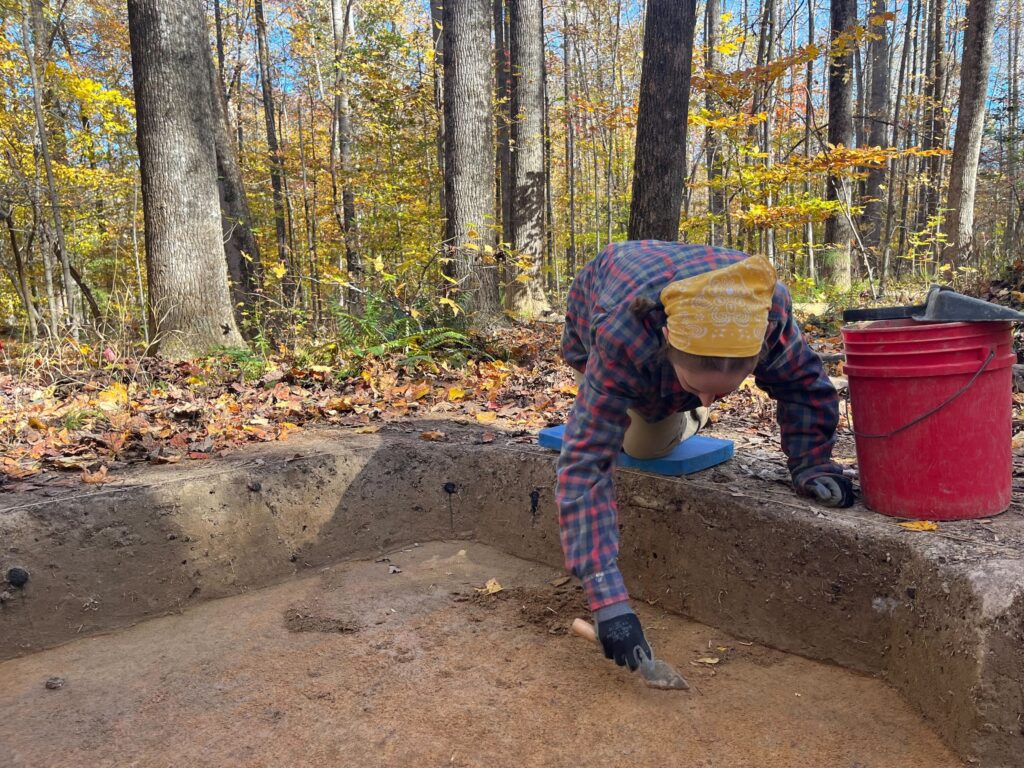Centuries-old documents told of Native American settlements in the Fones Cliffs area of the Rappahannock River in Virginia’s Northern Neck.
In the 1600s, English explorer John Smith wrote of how he and his men were attacked by Native Americans along the river. A document from the 1660s detailed how the Rappahannock Tribe was promised 30 blankets in exchange for more than 25,000 acres of their land.
But the exact location of these towns had never been pinpointed until now.
Archaeologists cross-referenced historic maps, documents and deeds with oral histories from Rappahannock tribal members. Then last fall, in the woods of Richmond County on areas near the bluffs, they started digging.
For months, the crew from St. Mary’s College of Maryland surveyed the land to try to find the early settlements but found nothing that could be linked to Smith’s foray. Then this summer, they came upon items on land the Rappahannock Tribe has been working to reclaim. The archaeologists are now revealing their discoveries of roughly 11,000 artifacts — some dating to the 1500s — ranging from tiny beads and shards of pottery with detailed markings to pieces of stone tools and pipes.
It was physical proof of the Rappahannock towns and villages that Smith had described.
“Indian people have long known of the land and our history and presence here,” said Anne Richardson, chief of the roughly 300-member Rappahannock Tribe, which is primarily in King and Queen County. “But so often things aren’t considered ‘real’ until they’re found or ‘discovered.’ This validates what we’ve long known.”
These findings come just seven years after the tribe was formally recognized by the U.S. government, bolstering its efforts to reclaim its ancestral land. The tribe has nearly finished closing deals to reclaim roughly 2,100 acres of land that was once theirs.
Experts from St. Mary’s College matched old documents with the oral histories passed down for generations by the Rappahannocks, including Richardson, who’s the fourth generation of her family to serve as the tribe’s chief and took over in the late 1990s.
They then walked into the woods, about a mile from the paved road, and marked off the property with pink and orange flags. They dug shallow pits and got on their hands and knees to scrape the dirt with trowels. At one spot, they found blackened dirt and rock — possible evidence of a hearth, the researchers said.
“This was where we lived,” Richardson said, as she recently watched the archaeologists work. “This could have been the spot where they gathered and cooked.”
Fones Cliffs sits on the north side of the Rappahannock River and is geologically unique because of its distinctive white diatomaceous earth — formed from fossilized remains of aquatic organisms from 5 million years ago when a shallow sea covered much of the area, according to Julia King, chair of the anthropology department at St. Mary’s College. Wildlife experts said it’s a rare spot because its wetlands are largely untouched and serve as an ideal habitat for bald eagles, fish and other animals.
The Rappahannocks once lived in villages and towns in the lush region, long before English settlers arrived, said Richardson and tribal elders and historians. They grew corn, squash and beans, hunted deer and rabbits, and harvested berries and plants. At the tribe’s peak in the mid-to-late 1500s, its land encompassed more than 350,000 acres along the river valley, and its population reached nearly 2,400.
In 1608, Smith — the English explorer — and his men left Jamestown to map the Chesapeake Bay. As they traveled by boat along the river, the Rappahannocks tracked their approach from the cliffs while other Indians, armed with arrows and disguised as bushes, hid nearby in the marsh. Just as the river narrowed, the Rappahannocks ambushed them, though Smith and his men managed to escape. In one of the most famous maps of the region, Smith showed several Rappahannock towns at Fones Cliffs.
“We had heard the Indigenous stories of towns on the cliffs, and we had seen John Smith’s map showing three towns up there, but we had not found artifacts supporting that until now,” said King, who with the tribe’s blessings, led the work at Fones Cliffs.
The Rappahannocks have been working for the last few years with the help of donors, government agencies and conservationists to reclaim their ancestral homelands. Their work is part of a national trend of returning land to Native American tribes that’s gained momentum in recent years, as a way of righting wrongs.
“These are people who were displaced from their land more than 400 years ago, and it’s so important that they’re given the opportunity to regain that connection that by right is theirs,” said Heather Richards, the Mid-Atlantic regional vice president for the Conversation Fund, which helped the Rappahannocks acquire a large parcel of land at Fones Cliffs.
Starting in the 1640s, the Rappahannocks’ land was taken by English settlers who turned much of it into plantations. In 1924, Virginia’s Racial Integrity Act tried to erase Native Americans by declaring that every state resident had to be either White or Black. The Rappahannocks — as well as other tribes in the Mid-Atlantic area — struggled to maintain their identity for generations and essentially became a landless tribe. Eventually, the Rappahannocks’ land at Fones Cliffs ended up in private ownership, and for the last three decades, much of it was used for logging.
During the colonial period, Edward DuBois Ragan — the Rappahannock’s tribal historic preservation officer — said the Rappahannocks “were alienated from this land, even though treaties guaranteed them the rights to occupy, hunt, fish and oyster there.”
Still, Rappahannock families had ceremonies, picnics and fish in the Fones Cliffs area, even though it was privately owned.
King’s team named one of the Fones Cliffs parcels after “Indian Peter,” who was a young man they learned about in documents who lived in the area at the turn of the 18th century. Researchers believe Indian Peter — the son of an Englishman and Rappahannock woman — was a servant who was promised freedom upon his father’s death. Archaeologists found roughly 2,500 artifacts on the Indian Peter area.
Fones Cliffs is divided into several parcels. One is owned by the U.S. Fish and Wildlife Service. Two others are owned by the Rappahannocks and protected with conservation easements. The tribe plans to build a welcome center on some of the land and create a system of trails and kiosks to educate the public about the land’s history and the tribe’s traditions.
“There’s a connection for us to this land,” Richardson said, “and getting it back is recovering our history.”
The post Location of historic Native American village was unknown — until now appeared first on Washington Post.




